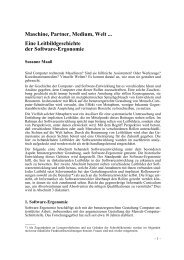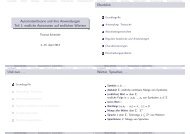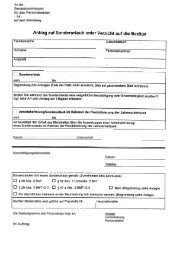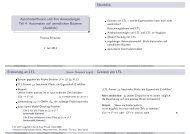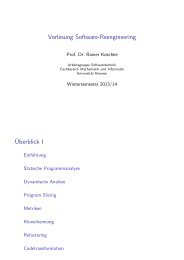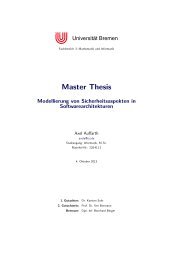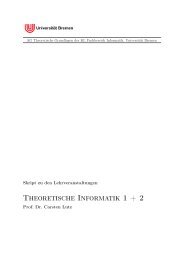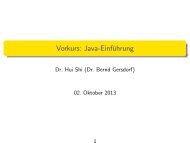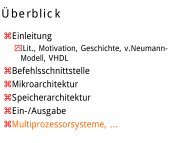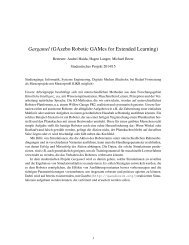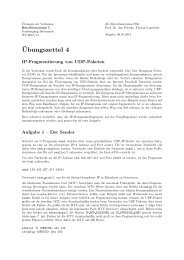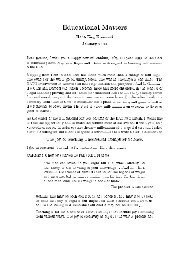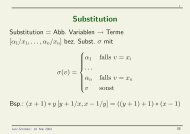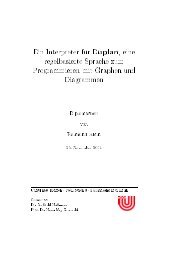- Page 2 and 3: 7KH8QLYHUVLW\RI0LFKLJDQ Where am I?
- Page 4 and 5: Acknowledgments This research was s
- Page 6 and 7: 2.4.2.2 Watson Gyrocompass ........
- Page 8 and 9: 6.4 Summary .......................
- Page 10 and 11: INTRODUCTION Leonard and Durrant-Wh
- Page 12 and 13: Part I Sensors for Mobile Robot Pos
- Page 14 and 15: 14 Part I Sensors for Mobile Robot
- Page 16 and 17: 16 Part I Sensors for Mobile Robot
- Page 18 and 19: 18 Part I Sensors for Mobile Robot
- Page 20 and 21: 20 Part I Sensors for Mobile Robot
- Page 22 and 23: 22 Part I Sensors for Mobile Robot
- Page 24 and 25: 24 Part I Sensors for Mobile Robot
- Page 26 and 27: 26 Part I Sensors for Mobile Robot
- Page 28 and 29: 28 Part I Sensors for Mobile Robot
- Page 30 and 31: CHAPTER 2 HEADING SENSORS Heading s
- Page 32 and 33: 32 Part I Sensors for Mobile Robot
- Page 34 and 35: 34 Part I Sensors for Mobile Robot
- Page 36 and 37: 36 Part I Sensors for Mobile Robot
- Page 38 and 39: 38 Part I Sensors for Mobile Robot
- Page 40 and 41: 40 Part I Sensors for Mobile Robot
- Page 44 and 45: 44 Part I Sensors for Mobile Robot
- Page 46 and 47: 46 Part I Sensors for Mobile Robot
- Page 48 and 49: 48 Part I Sensors for Mobile Robot
- Page 50 and 51: 50 Part I Sensors for Mobile Robot
- Page 52 and 53: 52 Part I Sensors for Mobile Robot
- Page 54 and 55: 54 Part I Sensors for Mobile Robot
- Page 56 and 57: 56 Part I Sensors for Mobile Robot
- Page 58 and 59: 58 Part I Sensors for Mobile Robot
- Page 60 and 61: 60 Part I Sensors for Mobile Robot
- Page 62 and 63: 62 Part I Sensors for Mobile Robot
- Page 64 and 65: Excitation actuator Metglas reed Tu
- Page 66 and 67: 66 Part I Sensors for Mobile Robot
- Page 68 and 69: 68 Part I Sensors for Mobile Robot
- Page 70 and 71: 70 Part I Sensors for Mobile Robot
- Page 72 and 73: 72 Part I Sensors for Mobile Robot
- Page 74 and 75: 74 Part I Sensors for Mobile Robot
- Page 76 and 77: 76 Part I Sensors for Mobile Robot
- Page 78 and 79: 78 Part I Sensors for Mobile Robot
- Page 80 and 81: 80 Part I Sensors for Mobile Robot
- Page 82 and 83: 82 Part I Sensors for Mobile Robot
- Page 84 and 85: 84 Part I Sensors for Mobile Robot
- Page 86 and 87: 86 Part I Sensors for Mobile Robot
- Page 88 and 89: 88 Part I Sensors for Mobile Robot
- Page 90 and 91: 90 Part I Sensors for Mobile Robot
- Page 92 and 93:
92 Part I Sensors for Mobile Robot
- Page 94 and 95:
94 Part I Sensors for Mobile Robot
- Page 96 and 97:
96 Part I Sensors for Mobile Robot
- Page 98 and 99:
98 Part I Sensors for Mobile Robot
- Page 100 and 101:
100 Part I Sensors for Mobile Robot
- Page 102 and 103:
102 Part I Sensors for Mobile Robot
- Page 104 and 105:
104 Part I Sensors for Mobile Robot
- Page 106 and 107:
106 Part I Sensors for Mobile Robot
- Page 108 and 109:
108 Part I Sensors for Mobile Robot
- Page 110 and 111:
110 Part I Sensors for Mobile Robot
- Page 112 and 113:
112 Part I Sensors for Mobile Robot
- Page 114 and 115:
114 Part I Sensors for Mobile Robot
- Page 116 and 117:
116 Part I Sensors for Mobile Robot
- Page 118 and 119:
118 Part I Sensors for Mobile Robot
- Page 120 and 121:
120 Part I Sensors for Mobile Robot
- Page 122 and 123:
122 Part I Sensors for Mobile Robot
- Page 124 and 125:
124 Part I Sensors for Mobile Robot
- Page 126 and 127:
126 Part I Sensors for Mobile Robot
- Page 128 and 129:
128 Part I Sensors for Mobile Robot
- Page 130 and 131:
CHAPTER 5 ODOMETRY AND OTHER DEAD-R
- Page 132 and 133:
132 Part II Systems and Methods for
- Page 134 and 135:
134 Part II Systems and Methods for
- Page 136 and 137:
136 Part II Systems and Methods for
- Page 138 and 139:
138 Part II Systems and Methods for
- Page 140 and 141:
140 Part II Systems and Methods for
- Page 142 and 143:
142 Part II Systems and Methods for
- Page 144 and 145:
144 Part II Systems and Methods for
- Page 146 and 147:
146 Part II Systems and Methods for
- Page 148 and 149:
148 Part II Systems and Methods for
- Page 150 and 151:
150 Part II Systems and Methods for
- Page 152 and 153:
152 Part II Systems and Methods for
- Page 154 and 155:
154 Part II Systems and Methods for
- Page 156 and 157:
156 Part II Systems and Methods for
- Page 158 and 159:
158 Part II Systems and Methods for
- Page 160 and 161:
160 Part II Systems and Methods for
- Page 162 and 163:
162 Part II Systems and Methods for
- Page 164 and 165:
164 Part II Systems and Methods for
- Page 166 and 167:
166 Part II Systems and Methods for
- Page 168 and 169:
168 Part II Systems and Methods for
- Page 170 and 171:
170 Part II Systems and Methods for
- Page 172 and 173:
172 Part II Systems and Methods for
- Page 174 and 175:
174 Part II Systems and Methods for
- Page 176 and 177:
176 Part II Systems and Methods for
- Page 178 and 179:
R e t r o r e f l e c t i v e m a r
- Page 180 and 181:
180 Part II Systems and Methods for
- Page 182 and 183:
182 Part II Systems and Methods for
- Page 184 and 185:
CHAPTER 8 MAP-BASED POSITIONING Map
- Page 186 and 187:
186 Part II Systems and Methods for
- Page 188 and 189:
188 Part II Systems and Methods for
- Page 190 and 191:
190 Part II Systems and Methods for
- Page 192 and 193:
192 Part II Systems and Methods for
- Page 194 and 195:
194 Part II Systems and Methods for
- Page 196 and 197:
196 Part II Systems and Methods for
- Page 198 and 199:
198 Part II Systems and Methods for
- Page 200 and 201:
200 Part II Systems and Methods for
- Page 202 and 203:
202 Part II Systems and Methods for
- Page 204 and 205:
204 Part II Systems and Methods for
- Page 206 and 207:
206 Part II Systems and Methods for
- Page 208 and 209:
208 Part II Systems and Methods for
- Page 210 and 211:
210 Part II Systems and Methods for
- Page 212 and 213:
212 Part II Systems and Methods for
- Page 214 and 215:
214 Part II Systems and Methods for
- Page 216 and 217:
216 Part II Systems and Methods for
- Page 218 and 219:
218 Appendices, References, Indexes
- Page 220 and 221:
220 Appendices, References, Indexes
- Page 222 and 223:
Systems-at-a-Glance Tables Odometry
- Page 224 and 225:
Systems-at-a-Glance Tables Global N
- Page 226 and 227:
Systems-at-a Glance Tables Beacon N
- Page 228 and 229:
Systems-at-a-Glance Tables Landmark
- Page 230 and 231:
Systems-at-a-Glance Tables Landmark
- Page 232 and 233:
Systems-at-a-Glance Tables Landmark
- Page 234 and 235:
This page intentionally left blank
- Page 236 and 237:
REFERENCES 1. Abidi, M. and Chandra
- Page 238 and 239:
238 References 31. Boltinghouse, S.
- Page 240 and 241:
240 References MOBOT-IV.” Proceed
- Page 242 and 243:
242 References 90. Dahlin, T. and K
- Page 244 and 245:
244 References 120. Fisher, D., Hol
- Page 246 and 247:
246 References 156. Janet, J., Luo,
- Page 248 and 249:
248 References 187. Larsson, U., Ze
- Page 250 and 251:
250 References 220. Nolan, D.A., Bl
- Page 252 and 253:
252 References 249. Sanders, G.A.,
- Page 254 and 255:
254 References 278. Turpin, D.R., 1
- Page 256 and 257:
256 References 309. EATON - Eaton-K
- Page 258 and 259:
258 References 349. SPSi - Spatial
- Page 260 and 261:
260 References 380. MacKenzie, P. a
- Page 262 and 263:
262 Index AC ..............47, 59,
- Page 264 and 265:
264 Index Datums ..................
- Page 266 and 267:
266 Index glass ...................
- Page 268 and 269:
268 Index lateral-post ............
- Page 270 and 271:
270 Index NPN .....................
- Page 272 and 273:
272 Index signal ..... 17, 31, 38,
- Page 274 and 275:
274 Index Abidi ...................
- Page 276 and 277:
276 Index Kak .....................
- Page 278 and 279:
278 Index Weiman ..................
- Page 280 and 281:
280 Index Video Index This CD-ROM c
- Page 282:
282 Index Paper 52 Paper 53 Paper 5



